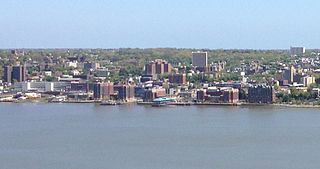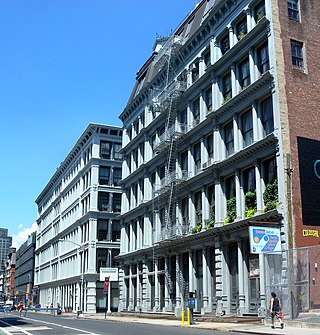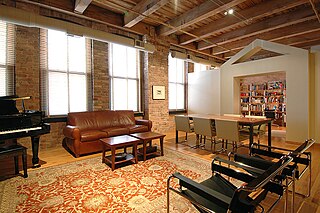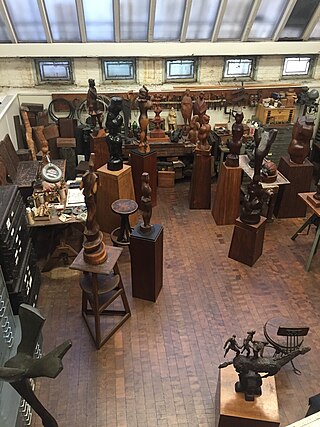
Yonkers is a city in Westchester County, New York, and a suburb of New York City. Developed along the Hudson River, it is the third most populous city in the state of New York, after New York City and Buffalo. The population of Yonkers was 211,569 as enumerated in the 2020 United States Census. It is classified as an inner suburb of New York City, located directly to the north of the Bronx and approximately 2.4 miles (4 km) north of Marble Hill, Manhattan, the northernmost point in Manhattan.

SoHo, sometimes written Soho, is a neighborhood in Lower Manhattan, New York City. Since the 1970s, the neighborhood has been the location of many artists' lofts and art galleries, and has also been known for its variety of shops ranging from trendy upscale boutiques to national and international chain store outlets. The area's history is an archetypal example of inner-city regeneration and gentrification, encompassing socioeconomic, cultural, political, and architectural developments.

40.729°N 73.993°W

Liberty Village is a neighbourhood in Toronto, Ontario, Canada. It is bordered to the north by King Street West, to the west by Dufferin Street, to the south by the Gardiner Expressway, to the east by Strachan Avenue, and to the northeast by railway tracks.

A loft is a building's upper storey or elevated area in a room directly under the roof, or just an attic: a storage space under the roof usually accessed by a ladder. A loft apartment refers to large adaptable open space, often converted for residential use from some other use, often light industrial. Adding to the confusion, some converted lofts themselves include upper open loft areas.

The Silver Center for Arts and Science is the home of the New York University College of Arts and Science and NYU's Grey Art Gallery. The Dean of the College of Arts & Science and the college administration are located in this facility which forms an imposing landmark on the eastern border of Washington Square Park.

40.93377°N 73.89795°W

Philip A. Amicone is an American politician who was the 41st Mayor of Yonkers, New York. He took office on January 1, 2004, after serving eight years as Deputy Mayor.

The Saw Mill River is a 23.5-mile (37.8 km) tributary of the Hudson River in Westchester County, New York, United States. It flows from an unnamed pond north of Chappaqua to Getty Square in Yonkers, where it empties into the Hudson as that river's southernmost tributary. It is the only major stream in southern Westchester County to drain into the Hudson instead of Long Island Sound. It drains an area of 26.5 square miles (69 km2), most of it heavily developed suburbia. For 16 miles (26 km), it flows parallel to the Saw Mill River Parkway, a commuter artery, an association that has been said to give the river an "identity crisis."

Pace University is a private university with its main campus in New York City and secondary campuses in Westchester County, New York. It was established in 1906 as a business school by the brothers Homer St. Clair Pace and Charles A. Pace. Pace enrolls about 13,000 students in bachelor's, master's and doctoral programs.

The Yonkers Public Library in Yonkers, New York, consists of three branch libraries. The main branch is the 'Yonkers Riverfront Library' which overlooks the Hudson River and New Jersey Palisades. Yonkers Riverfront Library is located in one of the former Otis Elevator buildings and it is across the street from the Yonkers train station. The new main library was opened in 2002, contains an area of 200,000 square feet (19,000 m2) and 4 stories.

50 Moganshan Road or "M50" is a contemporary art district in Shanghai, China, that houses a community of more than a hundred artists whose studios are open to the public. It is often compared with New York's SoHo and Beijing's 798 Art Zone. The art quarter has become a popular cultural attraction for local and international visitors alike, and was named among the top ten things to do in Shanghai by Time Magazine.

The U.S. Post Office for Yonkers, New York, is located on Main Street downtown, opposite the city's train station. It is a two-story stone building erected in the late 1920s. It is located in the 10702 ZIP Code, but serves the entire city, which has other ZIP codes between 10701 and 10710. In 1989 it was listed on the National Register of Historic Places, along with many other historic post offices in the state.

The former Yonkers Trolley Barn is located on Main Street in Yonkers, New York, United States. It is a massive steel frame brick building in the Renaissance Revival style built at the beginning of the 20th century. In 2002 it was listed on the National Register of Historic Places as the last remaining trolley barn in Westchester County and the only remnant of Yonkers' trolley system.

The Alexander Smith Carpet Mills Historic District is a national historic district located at Yonkers, Westchester County, New York. It includes 85 contributing buildings. It encompasses 19 stylistically varied mill buildings and six rows of workers' housing. They were developed between 1871 and 1930 in the vicinity of northeastern Getty Square along the banks of the Saw Mill River. The main mill building was originally built in 1871 and expanded between 1876 and 1883. It is a three-story, rectangular building, 52 bays wide and five bays deep in the Second Empire style. It features a four-story tower and a five-story tower. The workers' housing, known as Moquette Row, North and South, was built between 1881 and 1886. Many workers that lived in this housing originally were immigrants to the United States. They came from Scotland, Ireland, and Ukraine. The carpet works were developed by Alexander Smith (1818-1878) The company closed the Yonkers mills and relocated to Greenville, Mississippi, in 1954. At the time of its closing, there were 2,400 who worked at the carpet mill. At the time of World War II, there was 7,000 employees who worked at the mill.It was later absorbed into Mohawk Carpet, later Mohasco Corporation. The carpet weaving industry was revolutionized by looms invented in this plant by Alexander Smith and Halcyon Skinner. Skinner, an engineer, designed a loom known as the Axminster power loom, which revolutionized the production of carpets. A patent for this loom was created in 1877 and royalty rights were sold to European and American companies at the rate of twenty cents per yard of carpet produced.

Poughkeepsie Underwear Factory is a historic factory building located at Poughkeepsie, Dutchess County, New York. It was built in 1874 and is a 3+1⁄2-story, eight-bay brick building. It was expanded about 1887.

Philipse Manor Hall State Historic Site is a historic house museum located in the Getty Square neighborhood of Yonkers, New York. Originally the family seat of Philipse Manor, it is Westchester County's second oldest standing building after the Timothy Knapp House. Located near the Hudson River at Warburton Avenue and Dock Street, it is owned and operated by the New York State Office of Parks, Recreation and Historic Preservation.

Alexander Smith was a Yonkers, New York, businessman and political figure who founded the Alexander Smith & Sons Carpet Company and won election to the United States House of Representatives but died hours after being informed of his victory.

The Renee and Chaim Gross Foundation is a non-profit organization incorporated in 1989 dedicated to the study of modern American sculptor Chaim Gross (1902–91), his contemporaries, and the history of 20th-century American art. It is located in the sculptor's four-story historic home on LaGuardia Place in Manhattan's Greenwich Village neighborhood and is open to the public. In addition to the artist's sculpture and drawings, it also exhibits important works of American, European, Pre-Columbian and African art that the artist collected. In 2015, the Foundation won a Village Award from the Greenwich Village Society for Historic Preservation for its contributions as a resource to the downtown community.

The SoHo Memory Project is a nonprofit organization that celebrates the history of SoHo with a focus on the years 1960–1980, when it was a thriving artists’ community. It chronicles the neighborhood's evolution, charting cycles of development and placing current-day SoHo in the context of New York City's history. Its aim in preserving the past is to help the present generation make informed decisions about the future.


















